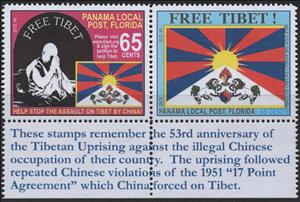Stamp: Free Tibet, Flag and Buddhist, with tabs (Cinderellas 2012)
Free Tibet, Flag and Buddhist, with tabs (Cinderellas 2012)
01 January (Cinderellas ) within release U.S.A. goes into circulation Stamp Free Tibet, Flag and Buddhist, with tabs face value 150 United States cent
| Stamp Free Tibet, Flag and Buddhist, with tabs in catalogues | |
|---|---|
| Colnect codes: | Col: US 2012-05 |
Stamp is horizontal format.
Also in the issue U.S.A.:
- Stamp - Free Tibet, Flag face value 85;
- Stamp - Free Tibet, Flag and Buddhist face value 65;
- Stamp - Free Tibet, Flag and Buddhist, with tabs face value 150;
Stamp Free Tibet, Flag and Buddhist, with tabs it reflects the thematic directions:
Buddhism, also known as Buddhadharma and Dharmavinaya, is an Indian religion based on teachings attributed to the Buddha, a wandering teacher who lived in the 6th or 5th century BCE. It is the world's fourth-largest religion, with about 320 million followers, known as Buddhists, who comprise four percent of the global population. It arose in the eastern Gangetic plain as a śramaṇa movement in the 5th century BCE, and gradually spread throughout much of Asia. Buddhism has subsequently played a major role in Asian culture and spirituality, eventually spreading to the West in the 20th century
A flag is a piece of fabric (most often rectangular or quadrilateral) with a distinctive design that is used as a symbol, as a signaling device, or as decoration. The term flag is also used to refer to the graphic design employed, and flags have since evolved into a general tool for rudimentary signalling and identification, especially in environments where communication is similarly challenging (such as the maritime environment where semaphore is used). National flags are patriotic symbols with varied wide-ranging interpretations, often including strong military associations due to their original and ongoing military uses. Flags are also used in messaging, advertising, or for other decorative purposes. The study of flags is known as vexillology, from the Latin word vexillum, meaning flag or banner.


